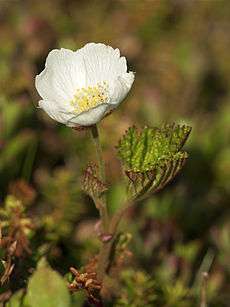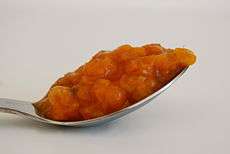Rubus chamaemorus
| Rubus chamaemorus | |
|---|---|
 | |
| Ripe cloudberry | |
| Scientific classification | |
| Kingdom: | Plantae |
| (unranked): | Angiosperms |
| (unranked): | Eudicots |
| (unranked): | Rosids |
| Order: | Rosales |
| Family: | Rosaceae |
| Genus: | Rubus |
| Species: | R. chamaemorus |
| Binomial name | |
| Rubus chamaemorus L. 1753 not Fisch. ex Ser. 1825 | |
 | |
| Synonyms | |
|
Synonymy
| |
Rubus chamaemorus is a rhizomatous herb native to cool temperate, alpine, arctic tundra and boreal forest, producing amber-colored edible fruit similar to the raspberry or blackberry. English common names include cloudberry,[1] bakeapple (in Newfoundland and Labrador), knotberry and knoutberry (in England), aqpik or low-bush salmonberry (in Alaska - not to be confused with true salmonberry, Rubus spectabilis),[2] and averin or evron (in Scotland).
Description
Unlike most Rubus species, the cloudberry is dioecious, and fruit production by a female plant requires pollination from a male plant.
The cloudberry grows to 10–25 cm (4–10 in) high. The leaves alternate between having 5 and 7 soft, handlike lobes on straight, branchless stalks. After pollination, the white (sometimes reddish-tipped) flowers form raspberry-sized aggregate fruits. Consisting of between 5 and 25 drupelets, each fruit is initially pale red, ripening into an amber color in early autumn.
Distribution and ecology
Cloudberries occur naturally throughout the Northern Hemisphere from 78°N, south to about 55°N, and very scattered south to 44°N mainly in mountainous areas. In Europe they grow in the Nordic countries and the Baltic states. In Asia they occur across northern Russia east towards the Pacific Ocean. Small populations are also found further south, as a botanical vestige of the Ice Ages; they are found in Germany's Weser and Elbe valleys, under legal protection, and in the moorlands of Britain and Ireland. In North America, cloudberries grow wild across most of northern Canada, Alaska, northern Minnesota, New Hampshire, and Maine; there is a historical record of a small population formerly occurring on Long Island east of New York City.[3][4]
The cloudberry can withstand cold temperatures down to well below −40 °C (−40 °F), but is sensitive to salt and to dry conditions. It grows in bogs, marshes and wet meadows and requires sunny exposures in acidic ground (between 3.5 and 5 pH).
Cloudberry leaves are food for caterpillars of several Lepidoptera species. The moth Coleophora thulea has no other known foodplants. See also List of Lepidoptera that feed on Rubus.




Wide distribution occurs due to the excretion of the indigestible seeds by birds and mammals. Further distribution arises through its rhizomes which can develop extensive berry patches. Cuttings of these taken in May or August are successful in producing a genetic clone of the parent plant.[5]
Cultivation
Despite great demand as a delicacy (particularly in Norway and Finland) the cloudberry is not widely cultivated and is primarily a wild plant. Wholesale prices vary widely based on the size of the yearly harvest, but cloudberries have gone for as much as €10/kg (in 2004).[6]
Since the middle of the 1990s, however, the species has formed part of a multinational research project. The Norwegian government, in cooperation with Finnish, Swedish and Scottish counterparts, has vigorously pursued the aim of enabling commercial production of various wild berries (Norway imports 200 - 300 tonnes of cloudberries per year from Finland). Beginning in 2002, selected cultivars have been available to farmers, notably "Apolto" (male), "Fjellgull" (female) and "Fjordgull" (female). The cloudberry can be cultivated in Arctic areas where few other crops are possible, for example along the northern coast of Norway.
Uses
The ripe fruits are golden-yellow, soft and juicy, and are rich in vitamin C. When eaten fresh, cloudberries have a distinctive tart taste. When over-ripe, they have a creamy texture somewhat like yogurt and a sweetened flavour. They are often made into jams, juices, tarts, and liqueurs. In Finland, the berries are eaten with heated "leipäjuusto" (a local cheese; the name translates to "bread-cheese"), as well as cream and sugar. In Sweden, cloudberries (sv. hjortron) and cloudberry jam are used as a topping for ice cream, pancakes, and waffles. In Norway, they are often mixed with whipped cream and sugar to be served as a dessert called "Multekrem" (cloudberry cream), as a jam or as an ingredient in homemade ice cream. Cloudberry yoghurt—molte-/multeyoughurt—is a supermarket item in Norway.[7]
In Newfoundland and Labrador, Canada, cloudberries are used to make "Bakeapple Pie" or jam. Arctic Yup'ik mix the berries with seal oil, reindeer or caribou fat (which is diced and made fluffy with seal oil) and sugar to make "Eskimo Ice Cream" or Akutaq. The recipes vary by region. Along the Yukon and Kuskokwim River areas, white fish (pike) along with shortening and sugar are used. The berries are an important traditional food resource for the Yup'ik.
Due to its high vitamin C content, the berry is valued both by Nordic seafarers and Northern indigenous peoples. Its polyphenol content, including compounds, such as benzoic acid, appears to naturally preserve food preparations of the berries.[8] Cloudberries can be preserved in their own juice without added sugar, if stored cool.[9]
Alcoholic drinks
In Nordic countries, traditional liqueurs such as Lakkalikööri (Finland) are made of cloudberry, having a strong taste and high sugar content. Cloudberry is used as a flavouring for making akvavit. In northeastern Quebec, a cloudberry liqueur known as chicoutai (aboriginal name) is made.[10]
Nutrients and phytochemicals
Cloudberries contain citric acid, malic acid, α-tocopherol, anthocyanins and the provitamin A carotenoid, β-carotene in contents which differ across regions of Finland due to sunlight exposure, rainfall or temperature.[11] The ellagitannins lambertianin C and sanguiin H-6 are also present.[12] Genotype of cloudberry variants may also affect polyphenol composition, particularly for ellagitannins, sanguiin H-6, anthocyanins and quercetin.[13]
Polyphenol extracts from cloudberries have improved storage properties when microencapsulated using maltodextrin DE5-8.[14] At least 14 volatile compounds, including vanillin, account for the aroma of cloudberries.[15]
Cultural references
The cloudberry appears on the Finnish version of the 2 euro coin.[16] The name of the hill Beinn nan Oighreag in Breadalbane in the Scottish Highlands means "Hill of the Cloudberries" in Scottish Gaelic.[17]
Harvesting on public property
In some northern European countries such as Norway, a common use policy to non-wood forest products allows anyone to pick cloudberries on public property and eat them on location, but only local residents may transport them from that location and only ripe berries may be picked.[18][19][20] Since 1970 in Norway, while it has been illegal to pick unripe cloudberries, transporting ripe cloudberries from the harvest location is permitted in many counties.[18]
References
- ↑ "BSBI List 2007" (xls). Botanical Society of Britain and Ireland. Retrieved 2014-10-17.
- ↑ University of Alaska @ Fairbanks, Cooperative Extension Service, Cloudberrries
- ↑ Biota of North America Program 2014 state-level distribution map
- ↑ Biota of North America Program 2014 county distribution map
- ↑ K. Rapp (1986). "Vegetativ oppformering av molte (Rubus chamaemorus L.)". Jord og Myr. 10: 1–11.
- ↑ Ville Heiskanen & Juho Erkheikki (28 July 2005). "Record Cloudberry Crop Lures Thousands of Finns to Lapland Bogs (see § "Prices Drop"; ¶ 1)". Bloomberg. Retrieved 13 August 2015.
- ↑ "TINE Yoghurt Molte". TINE.no.
- ↑ Thiem, B. (2003). "Rubus chamaemorus L. – a boreal plant rich in biologically active metabolites: a review". Biological Letters. 40 (1): 3–13.
- ↑ "Wild berries: cloudberries". Arctic Flavours Association. 2014. Retrieved 15 September 2014.
- ↑ "Chicoutai" (in French). terroirsquebec.com. Retrieved 7 April 2013.
- ↑ Jaakkola, M; Korpelainen, V; Hoppula, K; Virtanen, V (2012). "Chemical composition of ripe fruits of Rubus chamaemorus L. Grown in different habitats". Journal of the Science of Food and Agriculture. 92 (6): 1324–30. doi:10.1002/jsfa.4705. PMID 22083544.
- ↑ Kähkönen M, Kylli P, Ollilainen V, Salminen J-P, Heinonen M (2012). "Antioxidant activity of isolated ellagitannins from red raspberries and cloudberries". J Agric Food Chem. 60 (5): 1167–74. doi:10.1021/jf203431g. PMID 22229937.
- ↑ McDougall, G. J.; Martinussen, I; Junttila, O; Verrall, S; Stewart, D (2011). "Assessing the influence of genotype and temperature on polyphenol composition in cloudberry (Rubus chamaemorus L.) using a novel mass spectrometric method". Journal of Agricultural and Food Chemistry. 59 (20): 10860–8. doi:10.1021/jf202083b. PMID 21916411.
- ↑ Laine, P; Kylli, P; Heinonen, M; Jouppila, K (2008). "Storage stability of microencapsulated cloudberry (Rubus chamaemorus ) phenolics". Journal of Agricultural and Food Chemistry. 56 (23): 11251–61. doi:10.1021/jf801868h. PMID 18989975.
- ↑ Pyysalo, T; Honkanen, E (1977). "The influence of heat on the aroma of cloudberries (rubus Chamaemorus l.)". Zeitschrift für Lebensmittel-Untersuchung und -Forschung. 163 (1): 25–30. PMID 835340.
- ↑ "Finnish face of Euro coins: cloudberry, swan and heraldic lion". ec.europa.eu. Retrieved 3 April 2013.
- ↑ "Beinn nan Oighreag, Hill of the Cloudberries". Scotsman.com. 20 May 2008. Retrieved 7 April 2013.
- 1 2 Saastamoinen, Olli. "Forest policies, access rights and non-wood forest products in northern Europe". FAO. Retrieved 17 August 2015.
- ↑ "Guide to Cloudberries". My Little Norway. Retrieved 17 August 2015.
- ↑ "(in Norwegian) Dette har du lov til å gjøre på tur". UT.no, Norwegian Trekking and NRK. 2015. Retrieved 17 August 2015.
Further reading
- Resvoll, T. R., 1925. Rubus chamaemorus L. A morphological - biological study. Nytt Magasin for Naturvidenskapene, 67: 55-129.
- Resvoll, T. R., 1925. Rubus chamaemorus L. Die geographische Verbreitung der Pflanze und ihre Verbreitungsmittel. Veröffentlichungen des Geobotanischen Institutes Rübel in Zürich, 3: 224-241.
External links
| Wikimedia Commons has media related to Rubus chamaemorus. |
- Plants for a Future database report
- Den virtuelle floran - Distribution in Swedish with photos